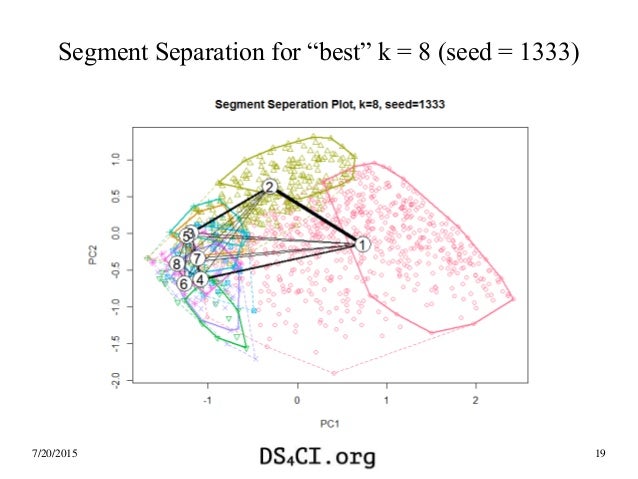The most comprehensive set of performance metrics for cluster models seems to be found using fpc:: I guess that typically I would use dist Nclus. This means that in steps 2 and 4, each observation is assigned to the cluster with the smallest value of:. Unlike hierarchical clustering, K-means clustering requires that the number of clusters to extract be specified in advance. Cluster analysis is a broad topic and R has some of the most comprehensive facilities for applying this methodology currently available. Additionally, this clustering approach can be sensitive to the initial selection of centroids. 
| Uploader: | Togrel |
| Date Added: | 15 June 2018 |
| File Size: | 45.28 Mb |
| Operating Systems: | Windows NT/2000/XP/2003/2003/7/8/10 MacOS 10/X |
| Downloads: | 59767 |
| Price: | Free* [*Free Regsitration Required] |
Subscribe to R-bloggers to receive e-mails with the latest R posts. Since K-means cluster analysis starts with k randomly chosen centroids, a different solution can be obtained each time the function is invoked.
kcca: K-Centroids Cluster Analysis in flexclust: Flexible Cluster Algorithms
How flexclhst I pass the distance matrix to cluster. Here, a dataset containing 13 chemical measurements on Italian wine samples is analyzed. Until Aug 21,you can buy the book: The graph can be produced by the following function.
The most comprehensive set of performance metrics for cluster models seems to be found using fpc:: The latter is easy; it is just model cluster.
K-means Clustering (from “R in Action”)
Figure 1 indicates that there is a distinct drop in within groups sum of squares when moving from 1 to 3 clusters. The function returns the cluster memberships, centroids, sums of squares within, between, totaland cluster sizes.

They are moved when doing so improves the overall solution. Stack Overflow works best with JavaScript enabled. After trying a few clustering algorithms, I got the best performance on my dataset using flexclust:: Since the variables vary in range, they are standardized prior to clustering 1. Sign up or log in Sign up using Google.
Additionally, observations are not permanently committed to a flexcluzt.
cclust: Convex Clustering in flexclust: Flexible Cluster Algorithms
As such, you will need to either use a different distance measure, such as the L1 distance suggested by renato, or find a different approach to evaluate the cluster assignments. K-means clustering can handle larger datasets than hierarchical cluster approaches. The adjusted Rand index provides a measure of the agreement between two partitions, adjusted for chance.
Email Required, but never shown. After three clusters, this decrease drops off, suggesting that a 3-cluster solution may be a good fit to the data. KeithHughitt your explanation is in fact a lot clearer than mine However, I am not sure that this makes sense from the flexcpust viewpoint: Unlike hierarchical clustering, K-means clustering requires that the number of clusters to extract be specified in advance.

It ranges from -1 no agreement to 1 perfect agreement. I went with cluster:: This approach is often recommended.
Here's an example using the Nclus dataset from flexclust. Sign up using Email and Password.
R for Data Analysis
Unicorn Meta Zoo 9: Modern Data Science with R: To leave a comment for the author, please follow the link and comment on their blog: The sharp decreases from 1 to 3 clusters with little decrease after suggest a 3-cluster solution.
Additionally, a plot of the total within-groups sums of squares against the number of clusters in a K-means solution can be helpful.
Active 3 years, 1 month ago. Richie Cotton Richie Cotton I can recreate the distance matrix used by kcca using the code from that function.

Комментарии
Отправить комментарий